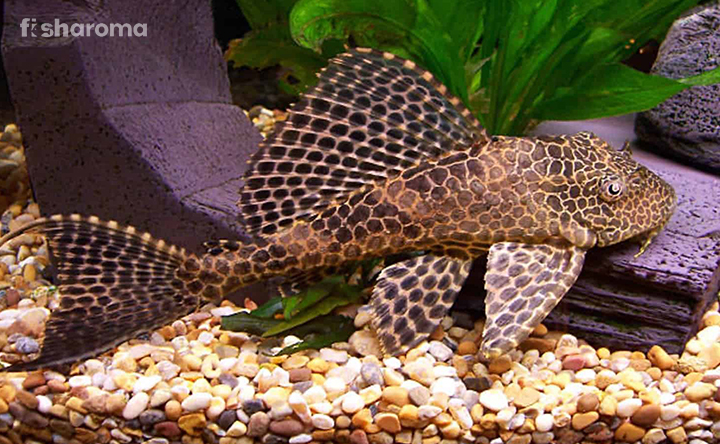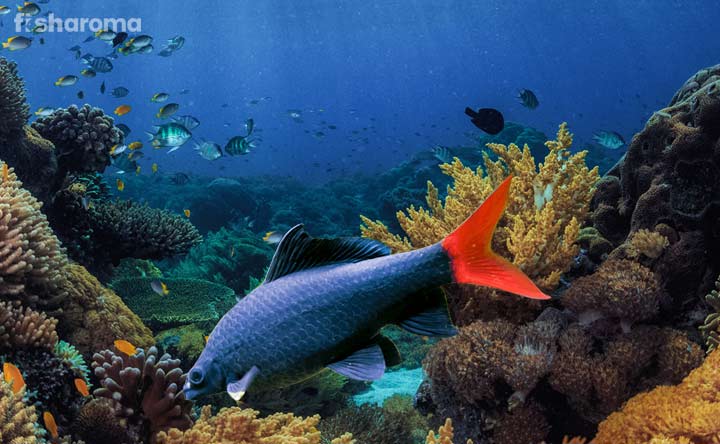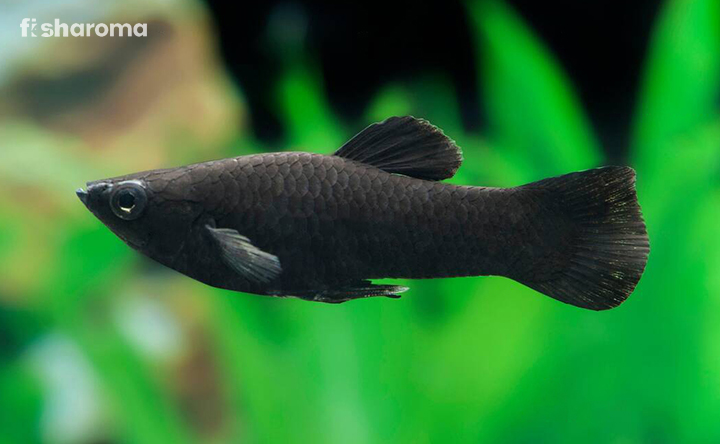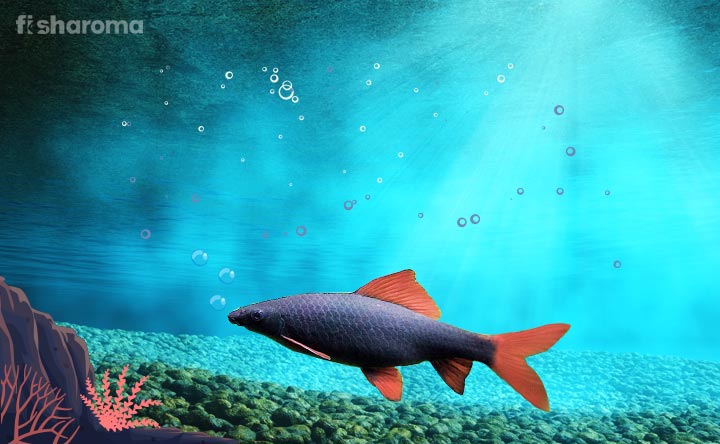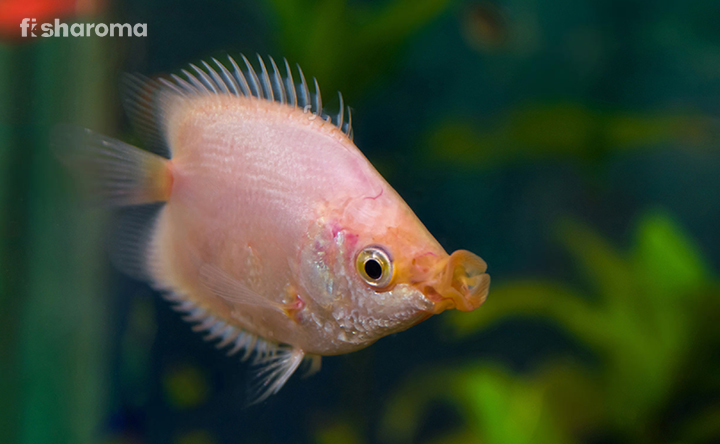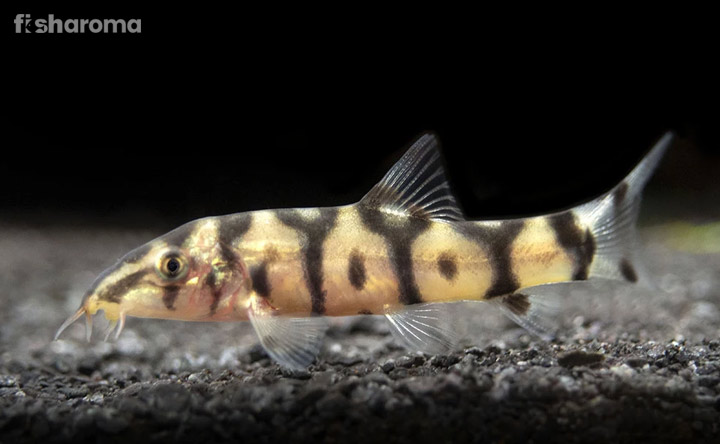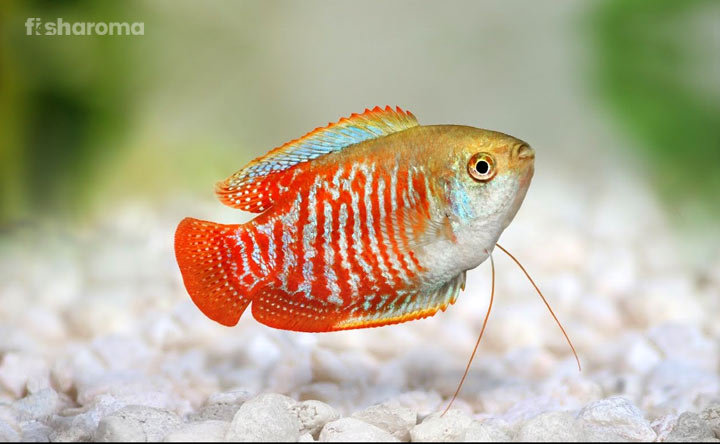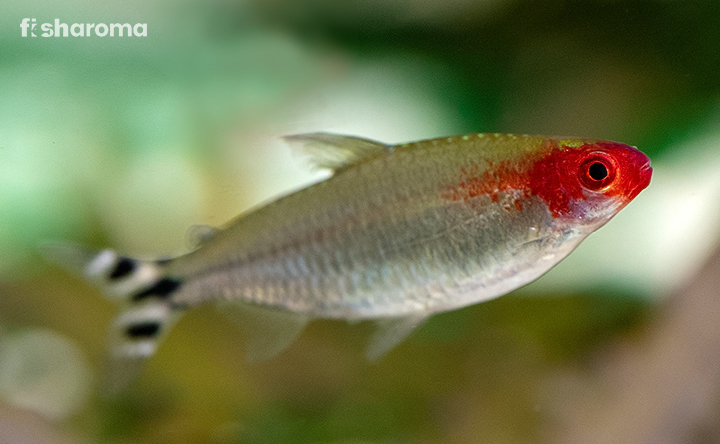Honey Gourami – The Complete Care Guide of this Awesome Pet Fish
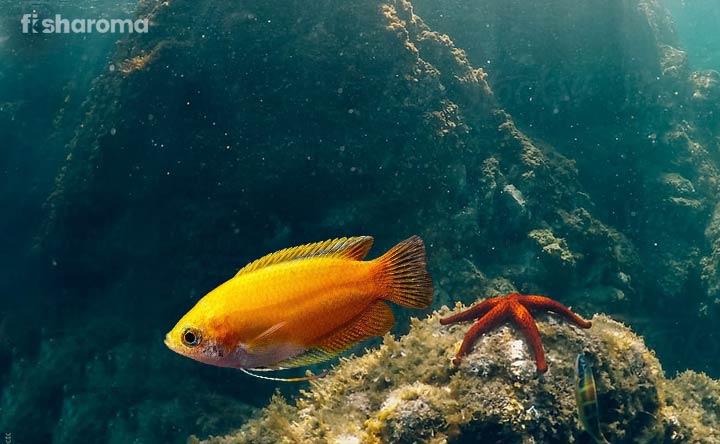
- Origin of Honey Gourami
- Appearance of Honey Gourami
- Diet Plan for Honey Gourami
- Habitat and Tank Requirements for Honey Gourami
- Water Type for Honey Gourami
- Temperament of Honey Gourami
- Suitable Tankmates for Honey Gourami
- Breeding Process of Honey Gourami
- Diseases of Honey Gourami with Interventions
A member of the Gourami family, Honey Gourami is a magnificent freshwater fish that is sometimes also seen in brackish water. If fishkeeping is your favorite hobby, then this tropical fish can be the best choice for you because it is a hardy fish that is easy to care for. Moreover, it enhances the beauty of your tank by its striking appearance and passive behavior. You just need to know its care guide if you want to include this vibrant fish in your aquatic family.
Quick Details
This Gourami fish has honey-red color on its body, so it is known as Honey Gourami. When it swims in the aquarium, the water reflects the beauty of sunset. Here we have provided a short detail about this freshwater fish.
| Scientific Name | Trichogaster chuna |
| Origin | Nepal, North India, and Bangladesh |
| Life-Span | 4-8 years |
| Colors | Honey-Orange, Silver-Gray, Black, Sunset Red |
| Temperament | Peaceful |
| Size | 1.5-3” (3.81-7.62 cm) |
| Diet | Omnivore |
| Family | Osphronemidae |
| Compatibility | With Peaceful Species |
| Tank Size | 10 gallons |
| Care Level | Easy |
Overview
Often kept in community tanks and aquatic museums, Honey Gouramis are also referred to as Red Flame Gourami, Red Honey Gourami and Sunset Gourami. It is classified as benthopelagic fish because it swims near the surface of the water. Aquarists collect a school of Gouramis from small ponds, streams and rivers for their residential and commercial aquarium.
Origin of Honey Gourami
Honey or Red Flame Gourami was first described by Buchanan and Hamilton in 1822. At that time, the scientific name of the male fish was Trichopodus chuna and the scientific name of the female fish was Trichopodus sota. After many years its scientific name changed into Trichogaster chuna that comes from an Ancient Greek word, ‘thriks’ which means ‘hair’, and ‘gaster’ which means ‘stomach’. This fish has long narrow fins and hair on the stomach, so the first part of its scientific name is ‘Trichogaster’.
Fishkeepers find this breed in soft mineralized water, which is surrounded by thick vegetation.
Appearance of Honey Gourami
This small honey-red colored fish is sometimes confused with Dwarf Gourami because both of them have similar size and shape. The body of Honey Gourami is narrow with small dorsal and anal fins. The ventral fins of the fish are narrow like a thread.
The male and female Gourami fish have different colors. The male fish has a beautiful honey-orange or honey-red color on its body. The female fish has a silvery-gray light color with a brown horizontal stripe in the middle part of the body. The ventral fins of the fish are dark blue or black.
In the Trichogaster genus, Honey Gourami and Dwarf Gourami are the smallest fish in the Gourami family. The male fish reaches up to 1.5” (3.81 cm), and the female fish reaches up to 2” (5.08 cm). This fish rarely grows up to 3” (7.62 cm).
The color of Dwarf Gourami is red and blue, but the color of Honey Gourami is orange, although both of them have the same size and shape.
Diet Plan for Honey Gourami
This omnivore fish eats everything in the wild, and it does not have any special food requirement. It will eat whatever you will provide it in captivity. As it is not a picky eater, so you don’t need to find special foods for this fish, but overfeeding may negatively affect the digestion system of the fish. You can choose simple food for this fish such as:
- Zooplankton
- Small Invertebrates
- Brine Shrimps
- Bloodworms
- Vegetables
- Plant Leaves
- Fresh Fruits
Don’t feed them more than twice or thrice a day, as per the plan of an experienced nutritionist. You can also feed them vegetable tablets, flakes, pellets and other readymade foods such as:
- API Tropical Fish Food
- Fluval A6577 Bug Bites Tropical Fish Small Granules
- Royal Pet Supplies INC Zoo Med Spirulina
Honey Gourami catches its prey by squirting above the water. This fish positions itself diagonally to the surface of the water to watch the prey. It jumps above the water to catch its food or prey once it sees its prey.
Habitat and Tank Requirements for Honey Gourami
Native to the freshwater of South Asia, this fish is found in the ponds, lakes, ditches, and rivers near Bangladesh, Nepal, and India. Usually, this fish is found in the slow-moving water. Gouramis have the habit of swimming in the upper and middle water column. You will also find this fish in flooded rivers during the monsoon season.
When you are setting an aquarium for this fish, try to follow a few requirements which will make your pet Gourami feel comfortable.
Tank Size
If you are keeping a pair, then a 20-gallon tank is recommended. For each new Gourami that you add to the tank, you need to provide 5-10 gallon of tank space for them.
Ornament
Honey Gourami prefers living in an eco-friendly environment, so if you keep floating aquatic plants in its aquarium, then it can live with comfort. Moreover, arrange caves in the tank, so that the fish can take rest and hide in the caves. Leave some surface areas uncovered, so that the fish can breathe properly because this fish reaches the surface to breathe. A sand substrate will be better instead of keeping rocks and stones in the aquarium.
Lighting
This is a diurnal fish, so it is active in day time. Therefore, you can arrange a LED light for the aquarium of this fish. Subdued light is not required for their tank.
Filter
Arranging a good filtration system will prevent the fish home from getting polluted. An electric sponge filter will keep the quality of the water maintained in an automation process.
Water Type for Honey Gourami
Honey Gourami prefers living in warm water, and it can also tolerate minor changes in the water chemistry such as hardness and pH level because it is a hardy fish. But try to maintain the temperature of the water because this fish has a labyrinth organ that is relatively sensitive to the changes in temperature. You can set a heater in the tank to maintain the consistency of water temperature in the fish home.
Temperature
The water temperature in the tank of Honey Gourami should be 71-82°F (21.66-27.77°C). Try to maintain the temperature of the water for the comfort of the fish.
pH Level
The pH level of the tank of the fish should be 6.0-7.5, which is a little bit acidic
Hardness
This fish likes dwelling in hard and slow-moving water. So, the hardness of the water should be 4-15 dGH.
Cleaning Method
Use a soft liquid and a brush to clean the corners and walls of the fish tank. You can use fresh aerated water to clean the tank. After washing out the decorations and walls of the tank, wipe it out with a cotton cloth.
Replacement Process
Change at least 15% water of the tank every week, and change about 25% of the water every month to maintain the hygiene of the fish home and keep the species away from health-related issues.
Temperament of Honey Gourami
This peaceful natured fish is perfect for the tank of inexperienced aquarists who have less idea about fishkeeping. It is an adjustable and hardy fish which does not have any special food requirement and other necessities. Honey Gourami is a shy and timid fish that needs caves to hide when attacked by predators or aggressive species.
It is not a schooling fish, but it does not mind if you keep it with its community members or with other calm-natured species. It needs dense vegetation to protect itself from bullying by fin-nipper species.
Suitable Tankmates for Honey Gourami
Picking the right tankmates for this shy and peaceful fish is very necessary, otherwise it may feel uncomfortable and stressed. Try to keep the same sized fish with Honey Gourami that will not harm the fish. You can keep some peaceful fish with it such as:
- Harlequin Rasbora
- Tiger Barb
- Clown Barb
- Zebra Danio
- Neon Tetra
- Coolie Loach
- Small Rainbow Fish
- Cory Catfish
- Otocinclus
- Snails
Don’t keep shrimps in the tank of Gouramis, otherwise they will be eaten up.
Unsuitable Tankmates
Experts say not to keep large predators and aggressive fish in the tank of this passive natured fish because Honey Gourami avoids conflicts and fights. Moreover, it is a shy natured species. Some unsuitable tankmates of this fish are:
- Oscar Fish
- Silver Dollar
- Large Catfish
- Pacus
- Red Tail Shark
Compatibility
Honey Gouramis are easy-going species that can be kept in pairs, single, or in groups of the same community members. Although they are not schooling fish, they enjoy the company of each other. Avoid keeping more than six of them in a tank because they don’t like an overcrowded tank.
Breeding Process of Honey Gourami
If the water condition of the tank is right, then it is easy to breed Honey Gourami. In the breeding season, a pair of Gourami fish builds a bubble nest under the leaves of the plants. So, if you buy a separate breeding tank of 10 gallons, then it will help the fish lay eggs comfortably.
In the breeding tank, the temperature of water should be 79-84°F (26.11-28.88°C); its hardness should be 8 dGH and its pH level should be 7.0. Moreover, add a gentle air-powdered sponge filtration, which will help in keeping the water of the breeding tank clean. You should also add vegetation that will help the fish building its nest under the leaves.
The male Gourami builds the bubble nest, and after building it, it shows the courting colors into blue-black by swimming towards the female fish. The changing colors of the male fish attract the female. After the mating the female releases about 20 eggs and the male fertilizes the eggs. The male fish is such a protective parent that it picks up the eggs in its mouth and put them in the nest and protects it until the eggs are hatched.
After 24-36 hours, the eggs of the fish are fertilized, and after three days the newborn fries can swim freely. You can feed infusoria or liquid fry food and baby Brine Shrimp to the fries.
Diseases of Honey Gourami with Intervention
Although Honey Gourami is a resilient fish, you need to change the water of the tank weekly, otherwise, this fish may get affected by various skin infections and tissue-related diseases. Some common diseases of this fish are:
- Velvet Disease – This is caused by a parasite, Oodinium pilularis that lives in the gills, mouth, and skin of the fish. This parasite causes infection in the skin and gills of the fish. Moreover, it is seen in the form of brownish and golden dust on the fins of the fish.
- Constipation – Wrong diet and malnutrition may be the reason for constipation. It will be better if you don’t feed frozen foods to this fish because those are the prime reasons for constipation.
- Ich or White Spot Disease – Due to the inappropriate tank setting and poor water condition, the fish is affected by Ich or other bacterial infections. In this condition, you will find big white patches on the body of the fish. Moreover, you will see the fish rubbing its body against the objects of the tank.
- Hexamitiasis or Hole in the Head – This infection is caused because of the parasitic protozoans that are known as Hexamita. Substrates are the main source of this parasite. If the substrate of the tank is not good, then Honey Gourami will get affected by Hexamitiasis, and you will find a hole in its head.
Along with water maintenance, a balanced diet is also needed to be planned for the health of the fish. Be wise in choosing the substrate of the tank because wrong substrate may cause potential risk in parasitic infections.
If your pet fish is prone to these diseases, then visit a veterinary doctor and start the treatment of your aquatic friend. Also, make a proper diet plan for your pet fish after taking suggestions from an expert nutritionist.
Interesting Facts about Honey Gourami
- Honey Gourami can breathe and survive in poorly oxygenated water, although they would prefer a well-oxygenated environment.
- The male Honey Gouramis are more protective of their newborn fries than the females.
- A dark substrate brings out their colors in the best possible manner.
- This fish likes swimming in a pair.
Acquire Ideas about More Gouramis
There are various species in the Gourami family that are often kept in the aquarium of beginners and experienced aquarists. The care guides about those fish will help in upbringing them. So, take a look at the care guides of different Gouramis:
- Paradise Gourami Fish: If you are finding a stunning and peaceful fish, then Paradise Gourami is one of the striking pet fish that is often seen in a beginner’s tank. To keep this orangish pet fish in your fish world, you may go through its care guide.
- Different Types of Gourami: Along with Honey Gourami, there are other Gouramis such as Pearl Gourami, Dwarf Gourami, Samurai Gourami, Chocolate Gourami, etc. If you want to know about their facts and care guide, then you may have a look at this article.
Honey Gourami is famous for its sunset appearance, which looks like the orange sun. Do you want to bring this sunset beauty in your aquarium? Don’t worry; we are here to help you in taking care of this stunning fish. Hope our comprehensive care guide will aid you in maintaining the comfort of this calm beginner-friendly pet fish.

